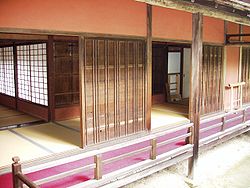
Manshuin Temple
Encyclopedia


Monzeki
Monzeki were Japanese Buddhist priests of aristocratic or imperial lineage. The term was also applied to the temples in which they lived....
, is a Tendai
Tendai
is a Japanese school of Mahayana Buddhism, a descendant of the Chinese Tiantai or Lotus Sutra school.Chappell frames the relevance of Tendai for a universal Buddhism:- History :...
temple located near the Shugakuin Imperial Villa at Sakyō-ku
Sakyo-ku, Kyoto
is one of the eleven wards in the city of Kyoto, in Kyoto Prefecture, Japan. It was created in 1929 when it was split off from Kamigyo-ku.It is located in the north-east corner of Kyoto city. In the east it borders the city of Ōtsu in Shiga Prefecture. In the south Sanjō Street separates it from...
, Ichijo-ji, Takenouchi-cho, in northeast Kyoto
Kyoto
is a city in the central part of the island of Honshū, Japan. It has a population close to 1.5 million. Formerly the imperial capital of Japan, it is now the capital of Kyoto Prefecture, as well as a major part of the Osaka-Kobe-Kyoto metropolitan area.-History:...
, Japan
Japan
Japan is an island nation in East Asia. Located in the Pacific Ocean, it lies to the east of the Sea of Japan, China, North Korea, South Korea and Russia, stretching from the Sea of Okhotsk in the north to the East China Sea and Taiwan in the south...
.
The temple was founded by Dengyo Daishi in the 8th century. It was then located near Mount Hiei
Mount Hiei
is a mountain to the northeast of Kyoto, lying on the border between the Kyoto and Shiga prefectures, Japan.The temple of Enryaku-ji, the first outpost of the Japanese Tiantai sect of Buddhism, was founded atop Mount Hiei by Saichō in 788. Both Nichiren and Honen studied at the temple before...
and known as Tobibo, but renamed Manshuin in 1108 or 1109. In the early Edo period
Edo period
The , or , is a division of Japanese history which was ruled by the shoguns of the Tokugawa family, running from 1603 to 1868. The political entity of this period was the Tokugawa shogunate....
the temple moved to its current site. Today the temple is notable both for its buildings and a fine garden.
The entry building contains a Tiger Room with images said to have been painted by Kano Eitoku
Kano Eitoku
was a Japanese painter who lived during the Azuchi–Momoyama period of Japanese history and one of the most prominent patriarchs of the Kanō school of Japanese painting...
狩野 永徳 (1543–1590), Bamboo Room with Edo
Edo period
The , or , is a division of Japanese history which was ruled by the shoguns of the Tokugawa family, running from 1603 to 1868. The political entity of this period was the Tokugawa shogunate....
wood-block prints, and Peacock Room with pictures by Ganku 岸駒 (1749/56–1839). The main temple hall (Great Shoin) dates from the early Edo period, and is now listed as an Important Cultural Property
Important Cultural Properties of Japan
The term is often shortened into just are items officially already classified as Tangible Cultural Properties of Japan by the Japanese Agency for Cultural Affairs and judged to be of particular importance to the Japanese people....
. It contains a Waterfall Room with slides by Kanō Tanyū
Kano Tanyu
was one of the foremost Japanese painters of the Kanō school. His original given name was Morinobu; he was the eldest son of Kanō Takanobu and grandson of Kanō Eitoku. Many of the most famous and widely known Kanō works today are by Tan'yū....
狩野探幽 (1602–1674), and Snowy Scenes Room with screen pictures by the same artist and shelves much like those in the Katsura Imperial Villa
Katsura Imperial Villa
The , or Katsura Detached Palace, is a villa with associated gardens and outbuildings in the western suburbs of Kyoto, Japan...
. The smaller hall (Small Shoin) is also an important culture property; it contains the Mount Fuji Room (pictures by Kanō Tanyū on the sliding doors); Twilight Room with royal throne and more paintings by Kano; and a tea room.
The temple's major garden is in the Karesansui (枯山水) style, and now designated as an eminent scenery; it contains a notable Pinus pentaphylla tree, now about 400 years old, set within an "island" on a stream of white sand. The inner garden is quite small, and features a stone basin and old well.

